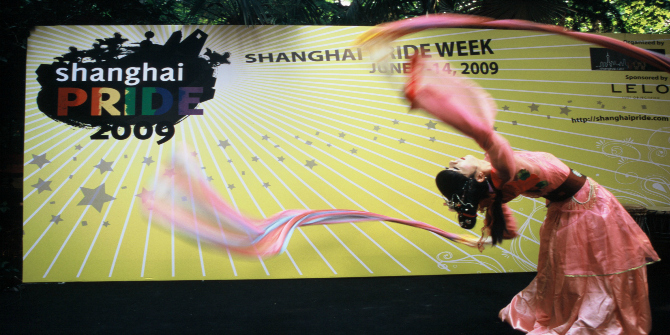In Transtopia in the Sinophone Pacific, Howard Chiang brings LGBTQ experiences in the Sinophone world to the forefront of trans studies, challenging both the Western framing of transgender and Chinese-centrism in the study of East Asian gender and sexuality. Contributing to both global trans studies and regional studies through its sharp geopolitical focus, the book broadens understandings of trans experiences and creates space for imagining different trans futures, writes Haiyan Huang.
Transtopia in the Sinophone Pacific. Howard Chiang. Columbia University Press. 2021.
 Find this book (affiliate link):
Find this book (affiliate link):![]()
As Howard Chiang acknowledges, ‘the politics of transness is most acute in cross-cultural contexts’. Situated between the different cultures of Taiwan and North America, Chiang has experienced conflicting reactions to his work on trans and uncomfortable feelings with his in-betweenness. For example, his editorial volume Transgender China (2012) was criticised for using the term ‘transgender’ in a way that was inconsistent with Western understandings of the concept. A decade later, at the inaugural Queer History Conference in 2019, he noted that he was uncomfortably caught between two worlds. Part of him was preoccupied with the political upheavals in Hong Kong, while the other part was celebrating ‘the fiftieth anniversary of Stonewall on the other side of the Pacific in the middle of a sunny pride month’ (2).
Against the backdrop of these dissonances, Chiang shares his concerns about Western hegemony in trans discourses and brings other regions, particularly Sinophone communities, into play when it comes to trans studies. Transtopia in the Sinophone Pacific is dedicated to building a post-identitarian continuum model in trans studies through the lens of geopolitics.
The book consists of two parts. In the first section, Chiang addresses two paradigms – the assumed Western rootedness of transgender studies and Chinese-centrism in the study of East Asian gender and sexual configurations. Chapter One challenges the Western origins and identity-based features of the umbrella term ‘transgender’. Chiang coins ‘transtopia’ – referring to ‘different scales of gender transgression that are not always recognizable through the Western notion of transgender’ – to bring LGBTQ experiences in the Sinophone world to the forefront of trans studies. The concept of ‘transtopia’ functions as an antidote to transphobia and avoids ‘a zero-sum game of two, three, or more gender configurations’ (22).
Chiang moves on to the importance of Sinophone studies for trans studies in Chapter Two, where he gives seven compelling reasons for its significance. A Sinophone framework – ‘the study of Sinitic-language cultures on the margins of geopolitical nation-states and their hegemonic productions’ (67) rather than a Chinese-centric perspective – denaturalises Chinese imperialism in East Asian gender/sexuality studies. It also helps to activate ‘a multidirectional critique that considers marginalization itself as a moving target of analysis’ (69). In other words, a postcolonial Western versus a non-Western binary is insufficient. There is a great deal of complexity both within the Global North and within the Sinophone world.
After unsettling these two paradigms, Chiang focuses on a series of case studies in the second part of the book to engage with uneven LGBTQ paths and histories in peripheral Sinophone areas. He proposes three methodologies for transgender historical analysis: titration; inscription; and creolisation.
‘Titration’ is defined by Chiang as ‘the proportional calibration of the way being cross-gendered and being human intersected’ (99). To elaborate on this concept, in Chapter Three, he reclaims the derogatory term renyao – ‘a native Chinese transgender concept’ perhaps best translated as ‘human prodigy’ but historically often used to equate gender transgression with ‘inhuman queerness’ (98). Chiang traces the multiple historical differentials in archiving the term in the 20th century. In particular, he recounts four streams of sensational media coverage of Zeng Qiuhuang, the most famous ‘human prodigy’ of 1950s Taiwan, to reveal how the meanings of renyao have metamorphosised over time and space. This historicisation underscores the marginality of both renyao and Taiwan given renyao’s long overdue potential to bring the non-human realm into queer studies. This displacement of Taiwan and Sinitic renyao discourse also leads to an assemblage of absence that highlights the weight of Taiwan’s global insignificance.
Chapter Four looks at different castrated bodies in some of the most famous Sinophone films, such as Farewell My Concubine, Flying Swords of Dragon Gate and M. Butterfly. These diffused (re)presentations of Chinese castrated bodies complicate gender idiosyncrasy and understandings of hegemonic Chineseness. Attention to embodiment also complements the tendency towards language-centrism and ‘introduces the body as an interpretive vector in Sinophone studies’ (138). Chiang further brings forward the concept of ‘intercorporeal governance’ to emphasise the role of the body ‘as a spectrum of inscriptive possibilities’ (156) to converge and contest transgender histories in relation to Sinophone cultures.
In the final chapter, Chiang describes how Western notions of transgender are creolised in contemporary Taiwan and Hong Kong through two examples. Comparing the history of the first gay pride event in Taiwan and the inclusion of ‘T’ (transgender) in reformulated tongzhi activism in the new millennium, he argues that radical change is closely related to the increasing visibility of transgender rights on a global level on the one hand, but also to local incidents such as the Yeh Yung-chih tragedy on the other. Western notions of transgender are creolised into ku’er (queer) in the contemporary Taiwan tongzhi movement. In contrast, in the case of W v. Registrar of Marriages in Hong Kong, both the Justices and the appellant asserted Wu’s rights to marriage on ‘the strict definition of marriage as a union between a man and a woman’ (198), leading to the creolisation of transgender citizenship in Hong Kong at the expense of excluding ‘T’ (transgender) in debates.
As an antidote to transphobia, Chiang’s transtopian approach emphasises a continuum thinking of trans as opposed to the discrete identity-based concept of transgender. This makes the book particularly interesting for Chinese scholars of gender and sexuality studies as it complicates ‘China’/’Chineseness’ and thus warns against the temptation to maintain any normative China-centric narratives. The book is also valuable for Western scholars of trans studies as it offers another perspective on understanding transgender and thus creates space for imagining a different trans future.
Despite its significant theoretical interventions and contributions, Transtopia in the Sinophone Pacific has several drawbacks. First, the overuse of STEM vocabulary such as ‘surjection, injection, asymptote, titration, differentials, chimera’ (13) and isomerism can make the text difficult to understand. Chiang justifies this in the book’s introduction by arguing that the adoption of these idioms is meant to bridge the gap between the humanities and the sciences. However, I am sceptical that this sharing of vocabularies would undermine ‘the subsidiary role often assigned to the humanities’ (14) or reduce the ‘animosity between the humanities and the sciences’ (14). It is also questionable whether this broad use of scientific metaphors is necessary to the author’s aim to accurately convey the complex and uneven trans pathways in Sinophone communities.
Furthermore, while the framework is useful in highlighting the internal complexities of gender and sexuality within Sinophone communities and helpful in circumventing China’s imperialism, mainland China is absent from the book’s overall trans analysis. The Sinophone approach rejects the binarism of the West and the rest found in postcolonial studies while simultaneously eschewing China-centrism. Yet, this not only renders this discussion of Sinophone trans studies highly incomplete, but also isolates mainland China as the ‘Other’. The ‘Chineseness’ Chiang advocates from the Sinophone perspective ironically seems to be located only in ‘peripheral’ areas such as Hong Kong and Taiwan.
Using extensive data, including archives, media reports, films and records, to historicise LGBTQ experiences in Sinophone communities, Chiang’s book nonetheless contributes to global trans studies as well as regional studies with its post-identitarian approach and sharp geopolitical focus.
Note: This review gives the views of the author, and not the position of the LSE Review of Books blog, or of the London School of Economics and Political Science. The LSE RB blog may receive a small commission if you choose to make a purchase through the above Amazon affiliate link. This is entirely independent of the coverage of the book on LSE Review of Books.






